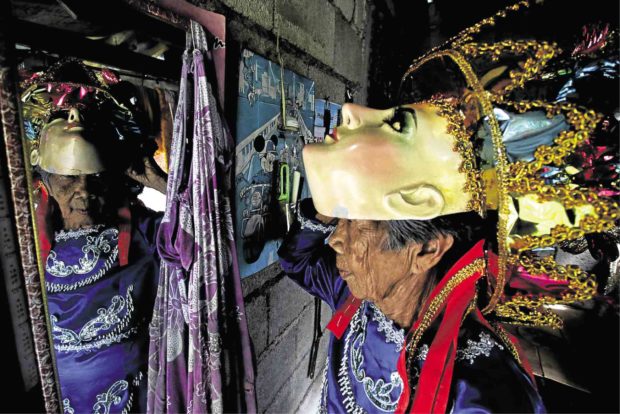Lenten tradition: The many faces of penitence in Marinduque

But who would have thought that the person behind that mask and a blue satin robe is a frail, old lady? She is Agripina Luna, or “Nanang Pinang,” the oldest female Morion at 84 from Mogpog town in Marinduque province.
Luna is among the hundreds of penitents joining Moriones, one of the oldest Lenten traditions of the Catholic Church, where participants wear masks and costumes mimicking the Roman soldiers who crucified Christ. The Morion walk the streets of the province starting Holy Monday and join religious activities until Easter Sunday.
Luna, a laundrywoman who first joined Moriones in 1989, said playing Morion had become her devotion and thanksgiving for a long life. “I will not stop as long as I can walk,” she said.
Christ’s passion
Moriones has become the most popular Lenten tradition and Marinduque’s top tourist draw. But it is only one of the many time-honored customs deeply rooted in the people’s religiosity, said Boac Bishop Marcelino Antonio Maralit Jr.
Article continues after this advertisement“It’s not really a show,” he said, but a way of remembering Christ’s life and passion.
Article continues after this advertisementIn Boac, the Lenten atmosphere begins a month before Holy Week.
Under star-lit skies on March 16, a cast of 180 gathered at the open-air Moriones Arena at Boac’s town center to rehearse for the “cenaculo” (or “senakulo”), a stage play reenacting the events leading to Christ’s crucifixion.
“They are all volunteers—students, fishermen, farmers, [from] all walks of life,” said Rufino Malitao Jr., the play director. The cenaculo is performed on Holy Wednesday and Maundy Thursday.
‘Kristo’
To Ronald Layag, 39, his devotion is a way of thanksgiving and for the protection of his family and the province. A provincial government employee and a Philippine Red Cross instructor, Layag has been playing the role of Jesus Christ in the cenaculo for the last five years.
Playing the central character is not easy. “I have to prepare a lot, physically,” he said. As Kristo, Layag has to carry a heavy wooden cross around town and endure the scourging from the Morion during “Via Crucis” (The Way of the Cross).
Kapatirang Morion
Layag plans to complete his vow as Kristo for seven years.
People playing Morion generally have the same petitions “for good health, for our families and for the forgiveness of our sins,” said Mark Montevirgen, 43, a penitent for 16 years. Montevirgen heads Kapatirang Morion ng Marinduque, a group of about 40 Morion in Boac founded in 1975.
Like Kristo, the role of Longinus, the one-eyed Roman soldier, is being “passed on” to a worthy heir, Montevirgen said. The character is played by Reynan Montalban, a “talyer” (car repair shop) owner.
Montalban owns about 10 Morion masks, which he lends to other Kapatiran members who could not afford their own.
Flower headdress
“You do the penitence only during the Holy Week. But if you don’t live by your devotion, that’s meaningless,” Montevirgen said.
In Mogpog, Jhun and Ella Mazon from Barangay Capayang have been making the “bulaklakan” (flower) headdress, similar to Luna’s, for 12 years.
“My prayer is that every year, my husband (Jhun) and I get to help more people wear a Morion,” she said.
Religious ‘twist’
While local officials acknowledged the tourism boost these traditions bring, Mogpog Mayor Augusto Leo Livelo said these were meant to “preserve” Marinduque’s customs.

DEVOTION Agripina Luna, 84, says she will continue wearing the Morion mask and join the Moriones tradition for as long as she can walk. —RICHARD REYES
Livelo said the local government was planning to build a museum showcasing the Moriones tradition and rewrite the traditional cenaculo to incorporate more biblical stories.
To Maralit, Marinduque’s Lenten rites show the “Filipino’s hospitality with a religious twist.”
“Anything you do is of value, especially if you do it out of faith,” he said.